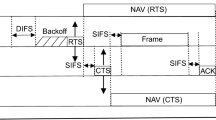Abstract
Due to interference, path loss, multipath fading, background noise, and many other factors, wireless communication normally cannot provide a wireless link with both a high data rate and a long transmission range. To address this problem, striping network traffic in parallel over multiple lower-data-rate but longer-transmission-range wireless channels may be used. In this paper, we propose a new striping method and evaluate its performances over multiple IEEE 802.11(b) channels under various conditions. Our extensive simulation results show that this method is quite effective for such an application.
Similar content being viewed by others
References
Hari Adiseshu, Guru Parulkar and George Varghese, A reliable and scalable striping protocol, ACM SIGCOMM’96 (8) (1996) 131–141.
C. Brendan, S. Traw and J.M. Smith, Striping within the network subsystem, IEEE Network (July/August 1995) pp. 22–29.
CISCO Aironet 350 Series Wireless Bridge Data Sheet, available at http://www.cisco.com
IEEE Computer Society LAN MAN Standards Committee, Wireless LAN Medium Access Control (MAC) and Physical Layer (PHY) Specifications, IEEE Std 802.11-1999. The Institute of Electrical and Electronics Engineering, New York, 1999.
F. Jacquet, Philippe Kauffmann, Michel Misson, Striping schemes for wireless communication system, The Fifth IEEE Symposium on Computer and Communications, Antibes, France, 4-6 July 2000
F. Jacquet and Michel Misson, Striping over Wireless Links: Effects on Transmission Delays, The 11th IEEE International Symposium on Personal Indoor and Mobile Radio Communications (PIMRC’00), 18-21 Sep. 2000.
J.D. Parsons, The Mobile Radio Propagation Channel (John Wiley & Sons, LTD., 2000).
Alex C. Snoeren Adaptive Inverse Multiplexing for Wide-Area Wireless Networks, IEEE GLOBECOM’99, December 1999.
W. Richard Stevens, TCP/IP Illustrated, Volume 1 (Addison Wesley, 1995).
S.Y. Wang, Optimizing the packet forwarding performance of wireless chain networks, Computer Communications 26(14) (2003) pp. 1515–1432.
S.Y. Wang, C.L. Chou, C.H. Huang, C.C. Hwang, Z.M. Yang, C.C. Chiou and C.C. Lin, The Design and Implementation of the NCTUns 1.0 Network Simulator, Computer Network 42 (2) (June 2003) pp. 175–197. (Available for download at http://NSL.csie.nctu.edu.tw/nctuns.html)
WaveLAN IEEE User’s Guide, Lucent Technology, 1998.
Wireless Data Forum. Cellular digital packet data system specification, Release 1.1 January 1995.
Author information
Authors and Affiliations
Corresponding author
Additional information
S.Y. Wang is an Associate Professor of the Department of Computer Science and Information Engineering at National Chiao Tung University, Taiwan. He received his Master and Ph.D. degree in computer science from Harvard University in 1997 and 1999, respectively. His research interests include wireless networks, Internet technologies, network simulations, and operating systems. He is the author of the NCTUns 2.0 network simulator and emulator, which is being widely used by network and communication researchers. More information about the tool is available at http://NSL.csie.nctu.edu.tw/nctuns.html.
C.H. Hwang received his master degree in computer science from NCTU in 2002 and currently is working for a network company.
C.L. Chou currently is a third-year Ph.D. student at the Department of Computer Science and Information Engineering, National Chiao TungUniversity (NCTU), Taiwan. He received his master degree in computer science from NCTU in 2002.
Rights and permissions
About this article
Cite this article
Wang, S., Hwang, C. & Chou, C. On Striping Traffic over Multiple IEEE 802.11(b) Wireless Channels. Wireless Netw 12, 301–319 (2006). https://doi.org/10.1007/s11276-005-5276-9
Published:
Issue Date:
DOI: https://doi.org/10.1007/s11276-005-5276-9




